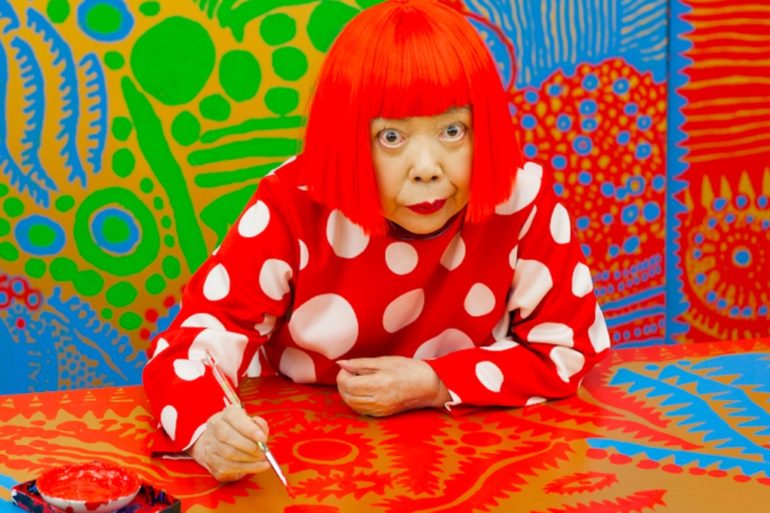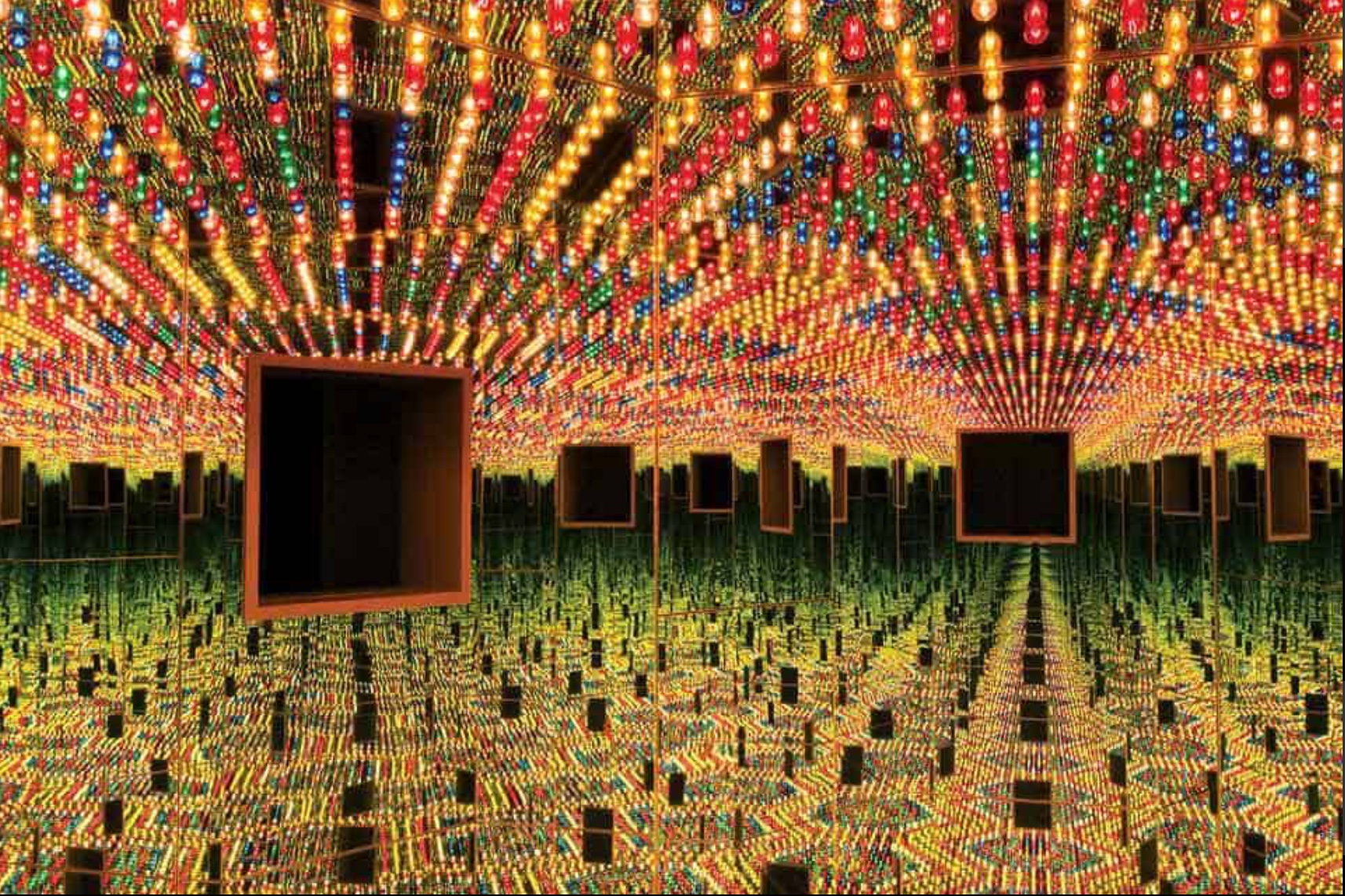
This post is also available in:

11.30 AM date for brunch at The Charcoal Yard, adjacent to the cinema with many well-known faces in the art world to celebrate the documentary film by Yayoi Kusama at the Wynwood O’Cinema, in an exclusive vision for a few days. Following a parallel dialogue more than an interview between Lynn Zelevansky, art historian and former director of the Carnagie Museum of Art, and Dannis Scholl, collector, patron and CEO of ArtCenter South / Florida.
A touching documentary of a soul oppressed by an anaffective mother and by the big problems of the latter that inevitably projected on her, triggering an obsessive-compulsive disease that only through art she is able to control, in the methodical and systematic repetition of points and networks that, between pop aesthetics and images of protest, give us her madness.
This is the short and concise definition of Yayoi Kusama.
An artist, for too many years alienated from the artistic society of which she desperately wanted to be a part of. Despite her conservative family, the Second World War in Japan and above all her mental illness, she got to have her revenge projecting herself on the international scene as one of the most singular and famous contemporary artists.
Yayoi Kusama was born in Matsumoto, Japan in 1929 in a rich conservative family combined for inheritance matters: her father was totally absent and her mother obsessed with her husband’s extra-marital affairs, on which she relies her daughter to keep a watch on. Yayoi will always report the consequences, coming to think of suicide on more than one occasion and having an aversion to sex, a question that will be explained in the works Accumulations in which Kusama holds armchairs, sofas and pieces of fabric furniture with a multiplicity of phallic protuberances, on which, with the Obsession installation, she will also be photographed naked, attempting to subvert her discomfort with regard to sex, thus coming to dominate it in this symbolic way.

At the age of 10 she began to have the first hallucinations from which she found benefit and comfort in his grandfather’s pumpkin plantations, where she abandoned herself to the most extravagant visions which she then fixes on the canvas making pumpkin, especially in her sculptural phase, one of the her favorite and recurring subjects, for which she will be recognized. At 13 she is sent to sew parachutes for soldiers of the army, a dowry that will allow her to work on her works with a certain familiarity while the noise of anti-aircraft sirens and the horrors of war will make her a champion in defense of peace and freedom. Opposing to the maternal figure, which sees herself as a servant-housewife, she begins to study art, first in Matsumoto and then in Kioto, where, to the detriment of Western techniques, she learns Nihonga: ancient Japanese traditional art produced on special -washi- or silk paper, with which you make the rolls to hang on the walls, to be unrolled for reading or to be inserted as a decoration in sliding doors.

In 1957, after having letter exchanges with Georgia O’Keeffe and tired of her mother’s harassment, she decided to leave Japan to go to New York, coming into contact with a purely male artistic environment. Alongside the Infinity Dots, where a set of dots of each size are flattened on the paintings becoming three-dimensional like a thousand little new planets, she produces the Infinity Nets: A painting that appears in the distance thin, delicate and monochromatic and that if observed closely reveals the intricacies of the work in which the background, almost completely obscured by small semicircles that fill the entire canvas, is shown only in the form of small dots while arcuate shapes all curve in the same direction, creating a wavy net that would continue to infinity if it were not for the edge of the canvas. Donald Judd will be among the firsts to buy one of her works, followed by Frank Stella and Joseph Cornell. The latter who is infatuated with Yayoi, will have much influence on her, having in turn an aversion about sex and will be at her side for a long time to the point that when Cornell dies, Yayoi will begin to create collages to cope with his death and to honor his work.
A controversial and extravagant artist, constantly looking for fame to self-validate her existence and claim her identity, in the course of her battle against mental illness, in 1966, she decided to participate clandestinely to the Venice Biennale. With the help of Lucio Fontana she set up a field of 1500 mirrored plastic spheres just outside the Italian pavilion, arranged side by side to create a reflecting field that distorts the images of reality. In the middle of the field two clearly visible signs: “Kusama Narcissus Garden” and “Your Narcissium for sale” and she, the artist in golden kimono who, like a seller walking, sells the balls for two dollars (1200 Italian liras at the time) by providing buyers a sphere in which they can reflect, thus becoming part of a small planet that becomes part of a new constellation. According to Danielle Shang, art critic: “The attitude of Kusama and her work is to be interpreted both as a self-promotion of Kusama and as a protest to the commercialization of art”. The same thing, between social-political protest and self-promotion happens with the performance Anatomic Explosion on Wall Street: where, in front of the New York Stock Exchange, naked actors move to the sound of bongos while Kusama acting as a priestess, paints blue circles on the bodies dancers attracting the attention of the police.
In addition to the repetitive paintings that give sensations of vertigo and hypnosis, and the soft sculptures Kusama produces the Infinity Mirror Rooms: installations of lights in environments entirely covered with mirrors in which the lights are reflected creating the illusion of an infinite space. Access is allowed to only one visitor at a time that, experiencing the installation becomes an integral part of the artist’s work, of his cosmos.

After a period in which the familiarity with personal and social fights led her to join different cultural movements, including hippie culture and the feminist movement, Yayoi Kusama, aware of her psychic malaise, decided to return to Japan and enter voluntarily, in 1977, at Seiwa, a psychiatric hospital where she lives and works to this day and where she has already completed more than 500 works, with a job finished every two / three days. The speed in the production of Yayoi’s works originates from the mother’s aversion to her artistic interest: she had to complete the works before her mother noticed and eliminated them.

The definitive turning point and self-proclamation as a contemporary artist took place in 1993, when, with the constant presence of her psychiatrist, she was invited, in a dedicated exhibition, to represent Japan at the 45th Venice Biennale. The works presented include paintings, three-dimensional objects and events that cover a period of over 30 years: from the early sixties to New York up to the early 90s and are intended to provide an understanding of the overall quality of Kusama’s art. Paradoxically, the Venice Biennale marks for her the beginning of her art for certain aspects of provocation, which will benefit Oldenburg, in her works in initials, and Warhol, drawing inspiration from her use of wallpaper and the way of treating repetition of the same image as a decorative and assertive expedient, both the end of her constant search for being part of the art world of the twentieth century, with a renewed interest not only for her art but also for her person, as shown by her own entry into the stable of the powerful gallerist Larry Gagosian.
And if in 1966 in a few hours she was expelled from the Venice Biennale, in the proliferation of lights, in the threatening and playful forms as well as in her polka dots and nets and in the infinite rooms with infinite mirrors, since 1993, she gathers planetary consents, including the Premio Imperiale, 2006: Japanese award for culture awarded annually by the Japan Art Association in memory of His Imperial Majesty Prince Takamatsu to the greatest exponents of the art world of which she is now part.
.
